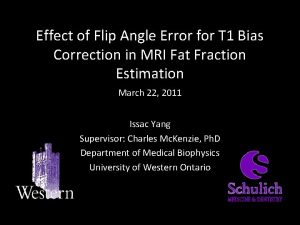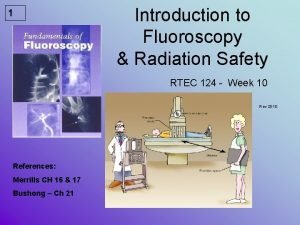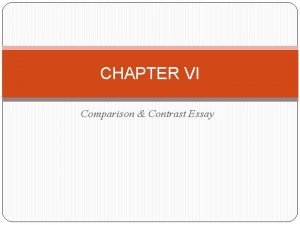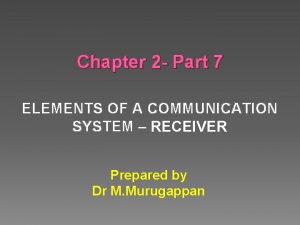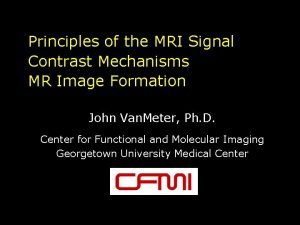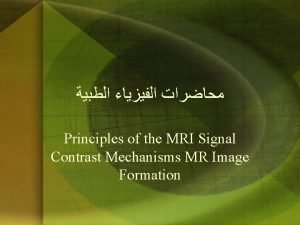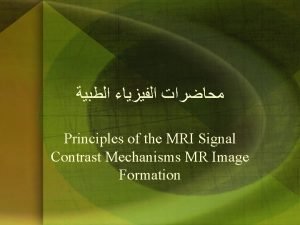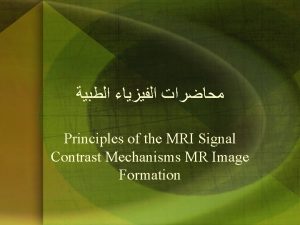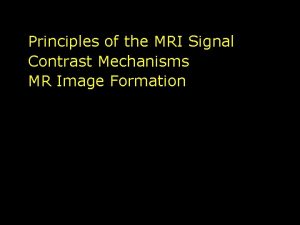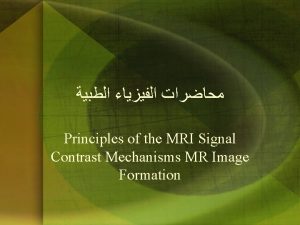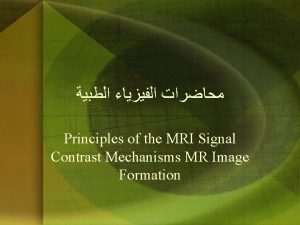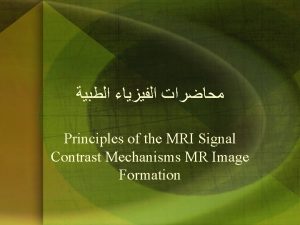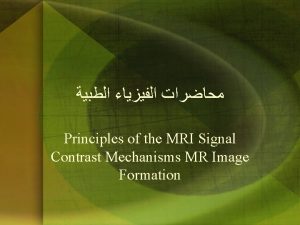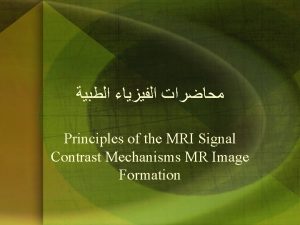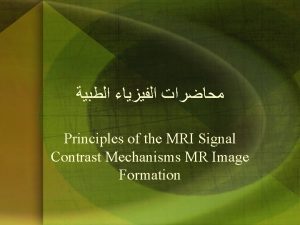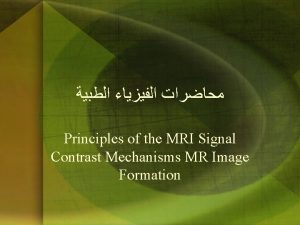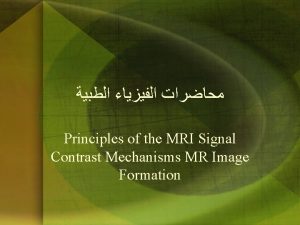Principles of the MRI Signal Contrast Mechanisms MR














- Slides: 14

ﻣﺤﺎﺿﺮﺍﺕ ﺍﻟﻔﻴﺰﻳﺎﺀ ﺍﻟﻄﺒﻴﺔ Principles of the MRI Signal Contrast Mechanisms MR Image Formation

Contrast Principles of the MRI Signal MR Image Formation Mechanisms ﺍﻟﻤﺤﺎﺿﺮﺓ ﺍﻟﺴﺎﺩﺳﺔ ﺳﻌﻴﺪ ﺳﻠﻤﺎﻥ ﻛﻤﻮﻥ. ﺍﻋﺪﺍﺩ ﺩ ﻛﻠﻴﺔ ﻣﺪﻳﻨﺔ ﺍﻟﻌﻠﻢ ﺍﻟﺠﺎﻣﻌﺔ ﻗﺴﻢ ﺍﻟﻔﻴﺰﻳﺎﺀ ﺍﻟﻄﺒﻴﺔ– ﺍﻟﻤﺮﺣﻠﺔ ﺍﻟﺮﺍﺑﻌﺔ John Van. Meter, Ph. D. Center for Functional and Molecular Imaging Georgetown University Medical Center

The MRI Sequence (Sans Spatial Localization) 1) Equilibrium (magnetization points along Bo) 2) RF Excitation (tip magnetization away from equilibrium) 3) Precession produces signal, dephasing starts 4) Readout signal from precession of the magnetization vector (TE) 5) Return to equilibrium and reapply RF Excitation (TR)

PULSE SEQUENCE DIAGRAM Usually sequences are depicted in the following way. You have the RF pulse delivery, then the next line shows slice selection gradient, then the phase gradient, then the frequency gradient and then the readout echo signal. There are two main parameters in MRI imaging. You can select the time that you want to repeat your RF pulse delivery called TR (repetition time) and the time you want the receiver coil to receive the signal from proton resonance called TE (echo time). Usually, the RF pulse is at 42. 58 MHz, which is the frequency at which proton in the hydrogen atoms resonate. Sequence Spin Echo

SPIN ECHO This is a classic pulse sequence. In Spin Echo, we apply a RF pulse 90 o relative the initial magnetic field, B 0 and then apply a RF pulse 180 o relative to the B 0 field to obtain our image. The reason for applying 90 o pulse is to dephase proton spins so that we can 'see' the differences in tissues. Moreover, an 180 o pulse is applied to rephase spins of protons so that we can measure an accurate T 2 echo since all spins will be rephased in the transverse axis. One may ask how can 180 o pulse rephase spins if they are all out of phase. Consider a race between a turtle and rat. When the race starts (relaxation begins), both are in the same place. As the rat runs faster, the distance between them widens. Then they both have to turn around and go back (180 o pulse) at the same speed to reach the finish line. Both will arrive at the same time (rephase) to the finish line. Remember: Longitudinal axis (T 1 relaxation); Transverse axis (T 2 relaxation)

SPIN ECHO One can already see that the echo signal after 90 o pulse is due to T 1 and T 2 relaxation since protons will attempt to align with the B 0 magnetic field in the longitudinal axis (T 1) as well as show decay in the transverse axis (T 2). Conversely, the echo signal after 180 o pulse is due to T 2 decay since the spins have been rephased and there is a net vector of all the spins in the transverse axis. Hence, 180 o pulse is applied in order to obtain accurate T 2 measurement as stated previously. Thereafter, the spins will realign in the longitudinal axis and one can then accurately measure T 1 time. In this way, one can obtain T 1 and T 2 weighted images based on this spin echo sequence by modifying the TR and TE time.

Spin-Echo Pulse Sequence

Multiple Spin-Echo

T 1 AND T 2 -WEIGHTED IMAGES As we have already discussed, the origin of T 1 and T 2 time is due to relaxation of protons in different planes. If we want a T 1 weighted image then the TR and TE time will have to be short. This image will show fat brighter relative to water. If we want a T 2 weighted image then the TR and TE time will have to be long. This image will show water brighter relative to fat.

Spatial Localization • Gradients, linear change in magnetic field, will provide additional information needed to localize signal • Makes imaging possible/practical – Remember the Indomitable? – Couldn’t spatially localize MRI signal instead moved subject to get each voxel • Nobel prize awarded for this idea!

Larmor Equation • Frequency (rate) of precession is proportional to the strength of magnetic field = *B

Dissecting Larmor Equation = * B Magnetic field Rate of precession Gyromagnetic Constant

Center Frequency • Center frequency is the frequency (i. e. rate) at which protons spin (precess) with just the static magnetic field • If the center frequency of a 1. 5 T scanner is 63 MHz what it the center frequency of our 3. 0 T scanner?

Center Frequency = * B = 63 MHz If B = 1. 5 T = 2 * 63 MHz If B = 3. 0 T = 126 MHz
 Fat signal mri
Fat signal mri Double contrast vs single contrast
Double contrast vs single contrast Tornado and hurricane venn diagram
Tornado and hurricane venn diagram What is compare and contrast text structure
What is compare and contrast text structure Effect signal words
Effect signal words Compare contrast signal words
Compare contrast signal words Nonfiction notice and note
Nonfiction notice and note Compare and contrast of cardinal and cedar waxwing
Compare and contrast of cardinal and cedar waxwing Baseband signal and bandpass signal
Baseband signal and bandpass signal Baseband signal and bandpass signal
Baseband signal and bandpass signal Digital signal as a composite analog signal
Digital signal as a composite analog signal Classification of signal
Classification of signal Unityex download
Unityex download Design principles contrast
Design principles contrast Basic principles of signal reproduction
Basic principles of signal reproduction
